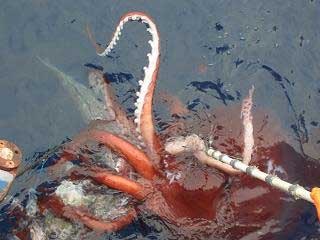The conventional wisdom underlying the US of A is that big is good. Hence the emphasis on macroeconomics - displacing and destroying livelihoods of people with lttle say - the indigenoue cultures of peoples of the Amazon, Indonesia, and before them, the Indians.
But big is not beautiful- Pollution on a small scale is abd enough, but pollution on a large, collossal scale is deadly. The destruction, in the name oil, of the livelihoods of the people of Indonesia, Equador, Colombia, to name a few, is evidence of that.
But the West's, particularly the USA's, lust for oil and other mineral resources ahs led to environmental, ecological and huma disasters on a world scale.
It is small consolation that when the world is cooked by the dents in the Ozone shield, the people in the West will also suffer.
There should be a curb on lifestyles that destroy the environment on a large scale.
There should be a limit on the size of cities.
There should be a limit on every endeavor that causes a change in the structure or topography of a land.
If I remember correctly. I read somewhere that the Prophet (saw) said that when your cities become large, move and found new cities.
Thursday, August 30, 2007
Big is not always desireable:
posted at 9:29 pm 0 comments
Monday, August 27, 2007
Something funny!
Blogger Edit posts shows what I have posted today, but the blog itself is uptodate only till yesterday. Where are my new posts going?
Well, it is OK now. :)
posted at 11:37 pm 0 comments
The Grand Canyon, USA

blue river

Grand Canyon

Grand Canyon


suset at Grand Canyon

Ribbon Falls
Glass Skywalk at the Grand Canyon


posted at 8:42 am 0 comments
Labels: Natural Wonders, World Heritage
Niagara Falls


The following is Mr. Richard Seaman's account (with pictures) of Niagara. He has travelled a lot, and taken a lot of brilliant pictures. Please do visit his website, and buy some prints from him.
The Flying Kiwi
Here's a photo looking South of the entire Niagara Falls area from The Whirlpool at the bottom to the Falls at top right. The United States is on the left, and Canada on the right. The bridge on the left-hand side is the Whirlpool Rapids bridge, so the water below it must be the Whirlpool Rapids! On the Canadian side there's a path beside these rapids which are quite spectacular in their own right. These class 6 rapids have 20 to 30 foot high waves, but these waves aren't caused by water going over rocks - the water's over 40 feet deep here. Instead, this is one of the few places in the world with rapids caused purely by a large volume of water falling relatively steeply through a narrow gorge. They are so dangerous that very few kayakers have ever run it.

Entire Area from North Of Whirlpool
The Whirlpool is a bit of a disappointment as the water does not swirl around and around.

Whirpool from the North
But the Whirlpool is interesting; if you look left of center here you can see the red and yellow Spanish Aero Car which traverses the Whirlpool on cables from one side to the other.

Whirlpool looking North
The strangest thing about the Whirlpool is how it was formed. The Niagara Falls have been moving up the Niagara River at a rate of 5 feet a year for the last 12,500 years but that changed when it got to this location, because this section consisted of soft sediment rather than rock. So it's thought that the entire Whirlpool area was cleared out in just a few days, or perhaps even a few hours. The resulting pool is 125 feet deep. Ironically, the mile long Glens immediately above the Whirlpool were much harder rock than anywhere else in the area and took almost 5,000 years to erode.

Whirlpool wide angle
At the bottom you can now see the Rainbow Bridge, then on the American side of the river there's the grotesque Prospect Park Observation Tower, right next to the American Falls, and on the right the Horseshoe Falls.

both Waterfalls and Banks from the North
There's Rainbow Bridge and the observation tower again. It was built to give Americans a better view of their waterfall, but it's not exactly an Eiffel Tower and it doesn't really work too well at its intended purpose, either!

Bridge and surroundings from the East
Below are the American Falls, with Goat Island on the right. At the right hand side of the American Falls you can see the Bridal Falls standing on their own - they look insignificant, but if they were on their own they'd be quite impressive. At the bottom of the Bridal Falls you can see yellow blobs, which are actually groups of people in yellow raincoats on the "Cave of the Winds" boardwalk, which gets up close and personal with the Falls. The "hurricane deck" is right next to the Falls.

American Falls and Goat Island
The Horseshoe Falls, also called the Canadian Falls, with Goat Island on the right. The immense cloud of mist shows how the Falls got their Indian name "Niagara", or "thundering water". On the Canadian side one can go through tunnels cut behind the actual waterfall, with side tunnels dug out so you can see the water pouring past.

Horseshoe Falls from the South
The Horseshoe Falls again, with a Maid of the Mists boat at the bottom. At the top and center of the photo you can see the water intake for the Canadian Niagara Falls power plant. Together with a power plant on the American side, it sucks off 50% of the water flow during the daytime and 75% at night. The flow down the river would be a full 10 feet higher if this water wasn't removed, but the falls would erode much faster.

Horseshoe Falls Medium Angle from North
posted at 7:33 am 1 comments
Labels: waterfalls
Istanbul-Fortress of Europe
Richard Seaman's trip to Qustuntuniya (Istanbul)
The guy is excellent. Lovely photos. Please visit his site:
The Flying Kiwi
 Fortesss of Europe
Fortesss of Europe Fortesss of Europe: East Side
Fortesss of Europe: East Side Fortesss of Europe: Tower closeup
Fortesss of Europe: Tower closeupposted at 6:00 am 0 comments
Labels: Turkey
The Nile Delta



The MERIS instrument flown onboard Envisat is particularly adapted to highlighting visible processes such as sediment input from rivers and the distribution of river sediment by marine coastal processes. 


A single acquisition over the Nile Delta made using the MERIS instrument reveals the striking contrast between the pale sands of the Sahara and the bright green of the course of the Nile and its delta, in the simulated true-colour image at left.
At right, bands 15, 13, and 2 have been used to bring out the extent of the Nile plume as sediment is carried from the river into the Eastern Mediterranean. Band 2 highlights surface sediment; bands 15 and 13, in the near-infrared, highlight the difference over land.
Once a seasonal phenomenon, the Nile flood, up to 1965 when the Aswan High Dam became fully operational, provided massive amounts of silt to the delta and the Eastern mediterranean, renewing soil fertility and providing nutrients on which shrimp and phytoplankton populations, thus fisheries, thrived. Today the sediment plume, negligeable when compared with the approximately 100 million metric tonnes of sediment retained behind the Aswan High Dam, is present year-round. It issues both from the Nile and from the Suez, as is clear in the MERIS image at right above.
see the following gallery and search for Nile Delta
Nile Delta photos from satellite
Another image shows that by enhancing a particular part of the data it is possible to render visible the processes which transport Nile and Red Sea sediment along the coast. Here, data in band 7 has been further stretched to show the sedimentation processes along the coast. Representing perhaps finer sediment, a visible blue plume farther north, which can also be seen in the 15, 13, 2 image, is probably a result of sediment being carried out by the river itself.
These images of the Nile Delta were acquired on March 1st, 2003.
A full description of the capabilities of the MERIS instrument can be found in the MERIS Product Handbook. Other images from ENVISAT's first year in orbit are available in the Envisat Image Gallery.
posted at 5:00 am 0 comments
Labels: Deltas, Egypt, environment
Sunday, August 26, 2007
Suckers of Octopus
Octopus suckers:
Each arm of the common octopus has a double row of circular suckers. Unlike those of squid, octopus suckers have no hooks or teeth. Suckers are muscular structures, and when pressed against a surface create low pressure in the suction cup that provides grip. The suckers pictured here belong to Oto, who spent some months recovering from an injury in a display aquarium at Wellington airport. He was returned to Cook Strait in October 2005.

posted at 9:45 pm 0 comments
Labels: animals: sea
Giant animals

Giant Jellyfish
snails & isopods
Giant Turtles
posted at 7:41 am 0 comments
Labels: animals: sea
The Giants Causeway

The Giants Causeway - 1

The Giants Causeway - 2

The Giants Causeway - 3

The Giants Causeway - 4

The Giants Causeway - 5

The Giants Causeway - 6
posted at 3:58 am 0 comments
Labels: Natural Wonders, World Heritage
Saturday, August 25, 2007
Collossal Squid
990 lb Collossal Squid caught live

990 lb Collossal Squid
The squid tried to eat a Toothfish caught on a Toothfish trawler line. He won't let go eevn when he was being hauled up.

A large Pantagonian Toothfish
The Collossal Squid again



The Colossal Squid is caught by longliner Isla Santa Clara. Photo by Ramon Ferreira Gomez.


The head and tentacles of the squid. The vast mantle could not be bought on board. Photo: Ramon Ferreira Gomez

Collossal Squid tentacles: (2nd of 2)
Colossal squid have well-armoured tentacles. The photograph shows the sharp, swivelling hooks on the ends of the tentacles.


A previous catch:

posted at 8:10 am 0 comments
Labels: animals: sea





















